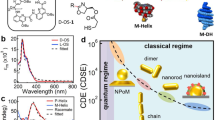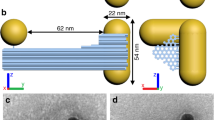Abstract
The ability to detect chirality gives stereochemically attuned nanosensors the potential to revolutionize the study of biomolecular processes. Such devices may structurally characterize the mechanisms of protein–ligand binding, the intermediates of amyloidogenic diseases and the effects of phosphorylation and glycosylation. We demonstrate that single nanoparticle plasmonic reporters, or nanotags, can enable a stereochemical response to be transmitted from a chiral analyte to an achiral benzotriazole dye molecule in the vicinity of a plasmon resonance from an achiral metallic nanostructure. The transfer of chirality was verified by the measurement of mirror image surface enhanced resonance Raman optical activity spectra for the two enantiomers of both ribose and tryptophan. Computational modelling confirms these observations and reveals the novel chirality transfer mechanism responsible. This is the first report of colloidal metal nanoparticles in the form of single plasmonic substrates displaying an intrinsic chiral sensitivity once attached to a chiral molecule.
This is a preview of subscription content, access via your institution
Access options
Subscribe to this journal
Receive 12 print issues and online access
$259.00 per year
only $21.58 per issue
Buy this article
- Purchase on Springer Link
- Instant access to full article PDF
Prices may be subject to local taxes which are calculated during checkout




Similar content being viewed by others
References
Gansel, J. K. et al. Gold helix photonic metamaterial as broadband circular polarizer. Sci. Am. 325, 1513–1515 (2009).
Schwaneck, A. S. et al. Broken time reversal of light interaction with planar chiral nanostructures. Phys. Rev. Lett. 91, 247404 (2003).
Kuwata-Gonokami, M. et al. Giant optical activity in quasi-two-dimensional planar nanostructures. Phys. Rev. Lett. 95, 227401 (2005).
Hendry, E. et al. Ultrasensitive detection and characterization of biomolecules using superchiral fields. Nature Nanotech. 5, 783–787 (2010).
Slocik, J. M., Govorov, A. O. & Naik, R. R. Plasmonic circular dichroism of peptide functionalized gold nanoparticles. Nano. Lett. 11, 701–705 (2011).
George, J. & Thomas, K. G. Surface plasmon coupled circular dichroism of Au nanoparticles on peptide nanotubes. J. Am. Chem. Soc. 132, 2502–2503 (2010).
Shukla, N., Bartel, M. A. & Gellman, A. J. Enantioselective separation on chiral Au nanoparticles. J. Am. Chem. Soc. 132, 8575–8580 (2010).
Řezanka, P., Záruba, K. & Král, V. Supramolecular chirality of cysteine modified silver nanoparticles. Colloids Surf. A 374, 77–83 (2011).
Elemans, J. A. A. W., de Cat, I., Xu, H. & de Feyter, S. Two-dimensional chirality at liquid–solid interfaces. Chem. Soc. Rev. 38, 722–736 (2009).
Ernst, K. H. Supramolecular Surface Chirality 209–252 (Springer, 2006).
Ernst, K. H. Molecular chirality in surface science. Surf. Sci. 613, 1–5 (2013).
Chon, H., Lee, S., Son, S., Oh, C. H. & Choo, J. Highly sensitive immunoassay of lung cancer marker carcinoembryonic antigen using surface-enhanced Raman scattering of hollow gold nanospheres. Anal. Chem. 81, 3029–3034 (2009).
Camden, J. P., Dieringer, J. A., Zhao, J. & van Duyne, R. P. Controlled plasmonic nanostructures for surface-enhanced spectroscopy and sensing. Acc. Chem. Res. 41, 1653–1661 (2008).
Temur, E., Boyaci, I., Tamer, U., Unsal, H. & Aydogan, N. A highly sensitive detection platform based on surface-enhanced Raman scattering for Escherichia coli enumeration. Anal. Bioanal. Chem. 397, 1595–1604 (2010).
Jackson, J. B., Westcott, S. L., Hirsch, L. R., West, J. L. & Halas, N. J. Controlling the surface enhanced Raman effect via the nanoshell geometry. Appl. Phys. Lett 82, 257–259 (2003).
Lin, A. W. H., Lewinski, N. A., Lee, M. & Drezek, R. A. Reflectance spectroscopy of gold nanoshells: computational predictions and experimental measurements. J. Nanopart. Res. 8, 681–692 (2006). .
Rocks, L., Faulds, K. & Graham, D. Rationally designed SERS active silica coated silver nanoparticles. Chem. Commun. 47, 4415–4417 (2011).
Barron, L. D., Hecht, L., Blanch, E. W. & Bell, A. F. Solution structure and dynamics of biomolecules from Raman optical activity. Prog. Biophys. Mol. Biol. 73, 1–49 (2000).
Freedman, T. B., Nafie, L. A. & Keiderling, T. A. Vibrational optical activity of oligopeptides. Biopolymers 37, 265–279 (1995).
Nafie, L. A. Vibrational optical activity. Appl. Spectrosc. 50, 14A–26A (1996).
Berova, N. et al. in Circular Dichroism: Principles and Application (eds Barron, L. D. & Hecht, L.) 667–702 (Wiley-VCH, 2000).
Barron, L. D., Hecht, L., McColl, I. H. & Blanch, E. W. Raman optical activity comes of age. Mol. Phys. 102, 731–744 (2004).
Adachi, K. et al. Chirality induction and amplification in methylene blue H-aggregates via D- and L-phenylalanine pre-adsorbed on the tungsten oxide nanocolloid surface. New J. Chem. 36, 2167–2170 (2012).
Angeluts, A. A. et al. Second harmonic generation upon reflection of light from the surface of a solution of mirror-asymmetric molecules: a new tool for studies of molecular chirality. Opt. Spectrosc. 87, 151–156 (1999).
Borovkov, V. V., Lintuluoto, J. M., Fujiki, M. & Inoue, Y. Temperature effect on supramolecular chirality induction in bis(zinc porphyrin). J. Am. Chem. Soc. 122, 4403–4407 (2000).
Borovkov, V. V., Yamamoto, N., Lintuluoto, J. M., Tanaka, T. & Inoue, Y. Supramolecular chirality induction in bis(zinc porphyrin) by amino acid derivatives: rationalization and applications of the ligand bulkiness effect. Chirality 13, 329–335 (2001).
Chilaya, G. Induction of chirality in nematic phases. Rev. Phys. Appl. 16, 193–208 (1981).
Chavan, S. P. & Khatod, H. S. Enantioselective synthesis of the essential oil and pheromonal component ar-himachalene by a chiral pool and chirality induction approach. Tetrahedron: Asymmetry 23, 1410–1415 (2012).
Fireman-Shoresh, S., Marx, S. & Avnir, D. Induction and detection of chirality in doped sol–gel materials: NMR and circular dichroism studies. J. Mater. Chem. 17, 536–544 (2007).
Ostovar pour, S., Bell, S. E. J. & Blanch, E. W. Use of a hydrogel polymer for reproducible surface enhanced Raman optical activity (SEROA). Chem. Commun. 47, 4754–4756 (2011).
Abdali, S. & Blanch, E. W. Surface enhanced Raman optical activity (SEROA). Chem. Soc. Rev. 37, 980–992 (2008).
Etchegoin, P. G., Galloway, C. & Le Ru, E. C. Polarization-dependent effects in surface-enhanced Raman scattering (SERS). Phys. Chem. Chem. Phys. 8, 2624–2628 (2006).
Barron, L. D. Molecular Light Scattering and Optical Activity (Cambridge Univ. Press, 2004).
Nafie, L. A. Theory of resonance Raman optical activity: The single electronic state limit. Chem. Phys. 205, 309–322 (1996).
Nafie, L. A. Vibrational Optical Activity: Principles and Applications (Wiley, 2011).
Abdali, S., Johannessen, C., Nygaard, K. & Nørbygaard, T. Resonance surface enhanced Raman optical activity of myoglobin as a result of optimized resonance surface enhanced Raman scattering conditions. J. Phys. Condens. Matter 19, 285205 (2007).
Abdulrahman, N. A. et al. Induced chirality through electromagnetic coupling between chiral molecular layers and plasmonic nanostructures. Nano. Lett. 12, 977–983 (2012).
Cao, T. et al. A comparison of the chiral counterion, solvent, and ligand used to induce a chiroptical response from Au25 nanoclusters. Nanoscale 5, 7589–7595 (2013).
Liu, M. et al. Spontaneous chiral symmetry breaking in metamaterials. Nature Commun. 5, 4441 (2014).
Iski, E. V., Tierney, H. L., Jewell, A. D. & Sykes, E. C. H. Spontaneous transmission of chirality through multiple length scales. Chem. Eur. J. 17, 7205–7212 (2011).
Fabrikanos, V. A., Athanassiou, S. & Lieser, K. Dastelung stabiler hydrosole von gold und silber durch reduktion mit athylendiamintetraessingsaure. Z. Naturforsch. B 612–616 (1963).
Becke, A. D. Density-functional thermochemistry. III. The role of exact exchange. J. Chem. Phys. 98, 5648–5652 (1993).
Frisch, M. J. et al. Gaussian 09, Revision D01 (Gaussian, 2009).
Marenich, A. V., Cramer, C. J. & Truhlar, D. G. Universal solvation model based on solute electron density and on a continuum model of the solvent defined by the bulk dielectric constant and atomic surface tensions. J. Phys. Chem. B 113, 6378–6396 (2009).
Novák, V., Šebestík, J. & Bouř, P. Theoretical modeling of the surface-enhanced Raman optical activity. J. Chem. Theory Comput. 8, 1714–1720 (2012).
Acknowledgements
This work was supported by the UK Engineering and Physical Sciences Research Council (EP/P504325/1 and GR/S75727/01), the Royal Society of Chemistry Analytical Sciences Division Studentship Scheme (GR/T05554/01), the Academy of Sciences (M200551205), and the Grant Agency (P208/11/0105, 13-03978S) of the Czech Republic. The authors thank E. Smith, M. Kadodwala, E. Hendry, C. Johannessen, S. Webb and A. Doig for discussions and D.G. acknowledges the Royal Society for support from a Wolfson research merit award.
Author information
Authors and Affiliations
Contributions
E.B. directed the project. D.G. and K.F. led the nanoparticle preparation and characterization. P.B. led the computational modelling. S.O.P. performed the SERROA studies. S.O.P. and L.R. performed SERS and characterization experiments. V.P. performed computational modelling. All authors contributed to preparing the manuscript, with E.B. and S.O.P. being the main authors.
Corresponding authors
Ethics declarations
Competing interests
The authors declare no competing financial interests.
Supplementary information
Supplementary information
Supplementary information (PDF 474 kb)
Rights and permissions
About this article
Cite this article
Ostovar pour, S., Rocks, L., Faulds, K. et al. Through-space transfer of chiral information mediated by a plasmonic nanomaterial. Nature Chem 7, 591–596 (2015). https://doi.org/10.1038/nchem.2280
Received:
Accepted:
Published:
Issue Date:
DOI: https://doi.org/10.1038/nchem.2280
This article is cited by
-
Detection and analysis of chiral molecules as disease biomarkers
Nature Reviews Chemistry (2023)
-
Liquid crystal-templated chiral nanomaterials: from chiral plasmonics to circularly polarized luminescence
Light: Science & Applications (2022)
-
All-dielectric chiral-field-enhanced Raman optical activity
Nature Communications (2021)
-
Recent developments in the chiroptical properties of chiral plasmonic gold nanostructures: bioanalytical applications
Microchimica Acta (2021)
-
Chiral-perovskite optoelectronics
Nature Reviews Materials (2020)



